If you just got your saxophone, you’re probably checking out all of the different parts. The metal clamp thing that holds the reed on? That’s a saxophone ligature.
Is it important? Does it matter? What are the best sax ligatures?
What is a saxophone ligature?
A ligature is the device that holds the reed on the mouthpiece. We are looking into saxophone ligatures, however, they also exist for other instruments, for example, clarinet ligatures.
Usually, they are made of metal.
Do saxophone ligatures make a difference?
You might be wondering why they matter.
Yes, in all honesty, you could probably go to the hardware store and figure out some sort of clamp that would keep the reed on. BUT, it probably would not have the same effect. That is because reeds are very finicky, for many reasons.
Reeds are porous, which allows them to vibrate. If the reed is pressed too hard it will not vibrate as well as it should. Also, the reed will be damaged. Depending on where the pressure is applied to the reed, the response will change, as well as the tone.
Also, the reed needs to vibrate freely. If the reed is too covered, that tends to dampen the sound, which keeps the reeds from responding.
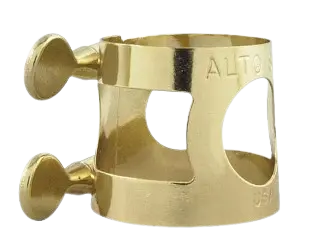
Does ligature affect the sound?
The saxophone ligature has a large effect on the tone and response of the instrument.
The mouthpiece, reeds, and ligature ARE the saxophone, the body of the saxophone is simply the resonator and the pitch controller.
A ligature with little connection to the reed lets the reed vibrate freely, and generally creates a brighter pitch. On the contrary, a ligature with a lot of connection with the reed will darken the sound. As well, if you tighten the front or back screw on the ligature, this can also change the sound somewhat.
Saxophone ligature placement
Most saxophone ligatures are metal, and the screws go on the bottom of the mouthpiece, right over the reed.
It is important to not overtighten the ligature.
This is most important because if the ligature is overtightened it will limit the resonance of the reed.
Also, eventually, you break either the screws or the ligature if you overtighten them regularly. You just want the saxophone ligature screws to be tight enough to keep the reed on without it moving around.
Some ligatures are inverted, meaning that the screws go on top.
In this case, the screw or screws would go on top of the mouthpiece. If you are using a brand new metal ligature, you might have to over-loosen it the first time so that the metal will conform to the reed.
“Leather” ligatures versus metal
Fabric ligatures generally darken the sound, while metal ligatures tend to brighten the sound. If you are looking for a darker sound, the fabric ligatures can help with this.
BUT, they can also dampen the reed and make it difficult to play.
For this reason, I tend to be careful with fabric ligatures. The only fabric ligatures that I use are the ones that have metal over the reed so the reed can still vibrate freely.
Metal ligatures allow the reed to vibrate more freely. This will make the sax easier to play with less resistance, and it will also create a brighter tone.
Do I need another ligature?
If you are a beginner, the standard saxophone ligature that came with the instrument will probably be fine for you. But, if you are an advancing player, you might want to experiment with other types of ligatures.
What is the best saxophone ligature?
There isn’t the best ligature, just one that’s best for you. I will go through some of the most popular brands and explain a little about each brand in this article.
The standard ligature that comes with the saxophone is generally fine to start, but if you are looking to change your tone or your resonance, you may want to change to another ligature.
I’ll go over some of the most popular brands here.
Bonade
Bonade ligatures look very similar to the standard ligature that comes with the saxophone, except that the ligature has two metal rods over the reed that allows for extra resonance and free-blowing.
They come in standard and inverted models, the inverted model having the screws on top.
These are great step-up from the standard ligature and are relatively inexpensive. I have previously used them on my alto sax to get a great responsive tone.
Bonade

- Two metal rods over the reed
- Extra resonance and free-blowing
- Standard and inverted models available
- Relatively inexpensive
Woodwind and Brasswind have also a great selection that you can find here.
Olegature (Oleg)
These have a unique design, using chain mail to create a ligature that can conform to any type of mouthpiece.
Similar to a fabric ligature, however since they are made of chain mail there is no problem with resonance, in fact, quite the opposite.
The chain mail keeps the reed from being overtightened and gives equal resonance in all parts of the reed. As well, the resonance can be changed by tightening or loosening the front or back screw.
Oleg claims that their ligature provides the best harmonic response of any ligature.
I have one for my baritone sax and have to say I’m impressed. It contributes to a big resonant bari sax sound, without any limitation in response whatsoever. However, on the alto, I feel it made the instrument much too bright. They are not cheap, however, but their claim that they provide the best harmonic response might be correct.
Oleg

- Unique design (can conform to any type of mouthpiece)
- Similar to a fabric ligature, but made of chain mail
- One of the best harmonic responses
- For darker sounds
Rovner Sax Ligatures
Rovner ligatures are characterised by a fabric design. They are often the first ligature that intermediate/advancing players will buy. They have a single screw on the top, which is part of their attraction in terms of aesthetics. Because of the fabric design, they tend to create a darker sound.
However, they also dampen the sound and make it more difficult to get the sax to respond.
Are Rovner ligatures good?
I used to use Rovners on both alto and baritone saxes to get a darker more classical sound, but I have stopped because they made it harder to play. The standard ligature that came with the saxophone was easier to play with.
However, if you would like to try them, they have a couple of models that have a metal plate over the reed. These are worth trying, as they will allow the reed more vibration.
Rovner
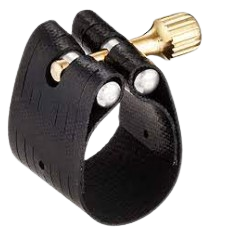
- Popular Step-up Option
- Characterised by a fabric design
- Great aesthetics
- For darker sounds
You can also check out Rovner ligatures on their website.
BG
These have a similar design to a Rovner, however, they generally have a metal plate for the reed. They provide a darker sound while still allowing the reed to resonate.
I have previously used them on my tenor. My particular tenor saxophone had a very bright natural tone, and I was looking for an option that would darken the tone while still allowing resonance for the reed.
BG
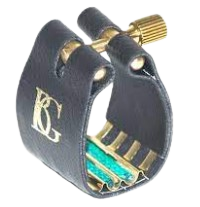
- Generally have a metal plate for the reed
- For darker sounds
- Allows the reed to resonate
Woodwind and Brasswind have also a good selection, which you can view here.
Harrison
These were originally a ligature made in the 1970’s and ‘80s. They have an H shaped pattern that goes over the reed. They are one of the preferred ligatures used by many professionals. The original ligatures were quite pricey and are no longer being made.
However, Rico (D’Addario) has acquired the rights to create an “H” ligature.
While they look the same, critics will say they are not the same as the original Harrison ligature. But the Rico version is much more affordable. I have tried them, and they have an improved resonance over a standard ligature, with a brighter sound.
Harrison
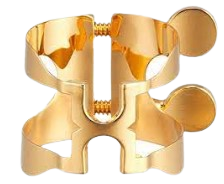
- H shaped pattern
- One preferred by professionals
- Now available as Rico (D’Addario)
Vandoren Optimum
Vandoren Optimum ligatures are becoming quite popular, and provide several different options.
The reed is held on by a metal plate, allowing the reed to vibrate freely.
One of the great features of these ligatures is that they come with three different removable plates, that you can change to get the sound that you want. This is an incredible feature because it allows you to have more control over your sound and change your sound depending on the type of music you are playing.
Vandoren Optimum

- Reed held on by a metal plate (allows it to vibrate freely)
- Becoming a popular option
- Three different removable plates
Bay (Charles Bay)
These ligatures are made of a very delicate metal that provides excellent response all around. The only drawback with these is that the metal is very thin, so special care must be taken to not break the metal. For these ligatures, it will be very important to not overtighten the ligature.
Bay
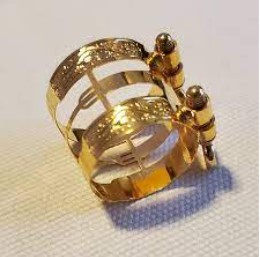
- Very delicate metal
- Excellent response all around
- Special care
Take into account your equipment setup
It’s always important to try out these ligatures against your sax equipment setup.
My personal experience
I have noticed that my mouthpiece and saxophone, as well as reeds significantly affect the tone when changing ligatures.
I originally used an Olegature on the tenor sax, then I switched tenors and the Olegature was too bright even though I was still using the same mouthpiece and reeds. This influenced me to switch to BG.
On alto I used Bonade, and sometimes Olegature, but when I switched to a different mouthpiece, these were incredibly bright.
After trying out many alto saxophone ligatures, now I use a Rico inverted ligature with a four-point system, similar to a standard ligature with a few differences.
This is an explanation of how equipment can change the experience with the ligature, and why it is important to try out the ligature with your particular equipment setup.
It is important to find the setup that works best for you.
Advice on the best saxophone ligature brands
If you just started playing, there is probably no reason why you would need to switch from the standard ligature that came with the saxophone.
As you advance, you might want to look into other options.
Best for beginners 🎷
A great first option for beginner saxes could be a Bonade ligature. These will significantly improve the resonance while being pretty similar to a standard ligature and are relatively affordable.
For darker tones 🎶
If you are looking for a slightly darker tone, you might want to try a BG ligature with the metal resonator.
H saxophone ligatures are also worth trying out, as the new models provide an inexpensive version of the famous Harrison ligatures.
For more advanced sax players 👑
If you are advancing and want the best, try Vandoren Optimum, Olegature or Charles Bay.
All three of these are a bit more complex in their design and will require more attention. However, they could substantially improve the tone.
Popular options🔥
Rovner ligatures are one of the most popular step-up options.
But for beginners, I would steer away from these as they are most likely just going to make it more difficult to play.
These could be an option later on if you need a darker tone, however, there are other options to get a dark tone.
Frequent Asked Questions About Sax Ligatures
Where do you put ligature on the saxophone?
Most saxophone ligatures are metal, and the screws go on the bottom of the mouthpiece, right over the reed.
Some ligatures are inverted, meaning that the screws go on top.
In this case, the screw or screws would go on top of the mouthpiece.
Are leather or metal ligatures better?
Metal ligatures allow the reed to vibrate more freely and make the sax easier to play with less resistance and a brighter tone. If you are looking for a darker sound, leather ligatures can help. BUT, they can also dampen the reed and make it difficult to play.
How tight should a saxophone ligature be?
You just want the saxophone ligature screws to be tight enough to keep the reed on without it moving around.
It is important to not overtighten the ligature. If the ligature is overtightened it will limit the resonance of the reed and eventually, you will break either the screws or the ligature.

Author: Cooper White
- Cooper is a Multi-Instrumentalist, with vast knowledge and experience performing with Sax, Flute, Clarinet, Keyboard, and Blues Harmonica.
- With a Bachelor’s Degree from the Berklee College of Music in Boston and studies in Classical Performance at the Lionel Hampton School of Music, he has also more than 10 years of performing professionally, whether while road touring in the U.S. or playing on different cruise ships.
- He is also an entertainer with his shows, as well as a producer of his music and others. Whenever he is not performing, he teaches individual online classes. He mostly plays Jazz, Classical and Popular music.
